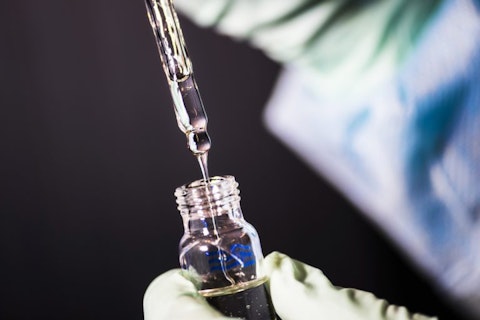Champions Oncology, Inc. (NASDAQ:CSBR) Q2 2023 Earnings Call Transcript December 13, 2022
Operator: Good day, ladies and gentlemen, and welcome to the Champions Oncology Second Quarter Fiscal Year 2023 Earnings Call. At this time, all participants have been placed on a listen-only mode and the floor will be opened for you questions and comments after the presentation. It is now my pleasure to turn the floor over to your host, Dr. Ronnie Morris. Sir, the floor is yours.
Ronnie Morris: Good afternoon. I am Ronnie Morris, CEO of Champions Oncology. Joining me today is David Miller, our Chief Financial Officer. Thank you for joining us for our quarterly earnings call. Before I begin, I will remind you that we will be making forward-looking statements during today’s call and that actual results could differ materially from what is described in those statements. Additional information on factors that could cause results to differ is available in our Forms 10-Q and Form 10-K. A reconciliation of non-GAAP financial measures that may be discussed during the call to GAAP financial measures is available in the earnings release. Overall, we had another good quarter with record revenue in our services business as well as progress in our drug discovery effort.
We continue to monitor the current economic environment and for the first time, we have noticed an effect on our business. During this quarter, specifically in September and October, we noticed a slowdown in bookings compared to prior quarters. While the quarter’s total bookings remained strong, they were below those obtained in our previous quarter. Our late-stage pipeline continues to be strong, and we feel that in Q2, there was a general delay when it came to finalizing a proposed statement of work from our customer base. We are halfway through Q3 and we are cautiously optimistic that bookings are back on track to Q1 levels. We are confident that our superior TumorBank, high-quality work and expanded services will continue to propel our growth even in these uncertain economic times.

Photo by CDC on Unsplash
With regards to Lumin, which is our multifaceted data platform, we have our software product and our data analytics product. As I discussed on our last quarterly call, Lumin adoption has been slower than anticipated. We still envision our data platform as an asset and part of our overall long-term strategy. However, we determined that we were at a crossroads with regards to our SaaS platform. We either needed to invest more heavily in both sales and marketing and our software support or to reduce some of our costs and we opportune time to increase investment. Given the current economic environment, and the multiple platforms we are working on to expand our pharmacology offerings, we’ve decided to reduce our Lumin investment for the time being.
While we are still signing up a small number of new users, the short-term focus will be to continue to learn from our active user base and to improve on the product. With regards to our drug development effort, we continue to make good progress. Our lead discovery programs are progressing well through its therapeutic discovery stages. As discussed last quarter, our partnership with Alloy recently reached a milestone with the completed development of a series of lead antibodies, exhibiting favorable biophysical binding and specificity characteristics. A lead candidate was selected from this series and evaluated as a promising antibody drug conjugate. We expect to start preclinical testing shortly. Our lead molecule from our Fannin collaboration is also expected to progress into preclinical testing in the next six months.
Both programs are the first of many potential therapeutic programs from our platform. In summary, during the second quarter, we had record revenue. We continue to expand our platform. We are reacting to the current economic environment and we are optimistic on our long-term growth prospects. We anticipate that our target discovery effort will progress into the preclinical phase, marking a significant milestone. Now let me turn the call over to David Miller for a more detailed review of the financial results.
See also 15 Most Conservative Companies in the US and 10 Biggest Dividend Cuts of 2022.
David Miller: Thanks, Ronnie. Our full results on Form 10-Q will be filed with the SEC on or before December 15. Our second quarter financial results were good with record revenue of $14.3 million compared to $11.8 million in the year ago period, an increase of $2.5 million or 21%. We generated operating income of $7,000. And excluding stock-based compensation and depreciation, we recognized adjusted EBITDA of approximately $686,000. Focusing as we do on results, excluding noncash expenses such as stock comp and depreciation, our total cost of sales was $7.2 million compared to $5.5 million in our second quarter last year, an increase of $1.7 million or 31%. The increase was primarily from compensation and supply expenses as we geared up from an increase in study volume.
Due to the current economic climate, we experienced an uptick in cancellations, limiting our anticipated revenue for the quarter and pressuring margins. Gross margin for our pharmacology services was 51% versus 53% in the year-ago period, while total gross margin was 49% compared to 53% for the same period last year. As Ronnie mentioned, we’ve decided to reduce our Lumin spend in the coming quarters, which should alleviate some of the total margin pressure. R&D expense was approximately $2.6 million compared to $2.3 million in the year-ago period, an increase of $300,000 or 13%. The increase is in line with guidance provided in the past as we indicated we’ll be ramping up our R&D investment, adding data to our TumorBank and investing in our therapeutic target discovery platform.
Sales and marketing expense was relatively flat $1.65 million compared to $1.6 million in the year ago period. Our G&A expense was at $2.1 million for the quarter compared to $1.6 million a year ago, a 30% increase. The increase was primarily due to compensation and IT expense as we invest in upgrading our infrastructure to support company growth. Additionally, we increased our bad debt allowance due to the current economic conditions. In total, our cash-based expenses were $13.6 million for the second quarter of fiscal 2023 compared to $11 million in the same period last year, an increase of approximately $2.6 million or 23% with the increase primarily stemming from cost of sales as we built in infrastructure to support higher revenue levels.
Now turning to cash. At the end of the quarter we had $10.8 million of cash on the balance sheet, an increase of $2.8 million from our prior quarter. For the quarter, net cash generated from operating activities was approximately $3.3 million, primarily due to positive cash-based operating results and an increase in accounts payable in the ordinary course of business. Cash used in investing activities of $600,000 was primarily due to equipment purchases for our laboratories. In summary, we had a good financial quarter, hitting a new revenue record of $14.3 million. As discussed, we experienced a slowdown in bookings in the quarter, along with an increase in cancellations. While we’re cautiously optimistic that bookings will reaccelerate in the second half of the year, the slowdown in bookings and increase in cancellations will likely impact total revenue for the year.
Accordingly, we’re expecting our total revenue growth for fiscal 2023 to be in the 10% to 15% range, down from the approximate 20% range provided at the beginning of the year. We’re well positioned to weather this revision, and we are excited about the company’s overall progression and long-term prospects. We look forward to our next update call in mid-March. We would now like to open the call to your questions.
Q&A Session
Follow Champions Oncology Inc. (NASDAQ:CSBR)
Follow Champions Oncology Inc. (NASDAQ:CSBR)
Operator: Thank you. Ladies and gentlemen, the floor is now open for questions. And the first question is coming from Matt Hewitt with Craig-Hallum. Matt, your line is live.
Unidentified Participant: Hi. This is Jack on for Matt. So for the first question is following a choppy Q3 reporting season where some companies spoke of headwinds due to the current weak biotech funding environment. I’m just curious what you’re seeing and hearing from your customers? Thanks.
Ronnie Morris: Yes. So we’re still seeing — we look at a couple of different key performance indicators. We look at the pipeline, which includes conversations, interest from our pharma customers and then we look at the actual SOW signings. What we’re seeing is, a robust pipeline, a lot of conversations, a lot of discussions, there’s a big need out there. But what we think we’ve been seeing over the last couple of months or we saw in the middle of Q2 was just more scrutiny, longer time to the signing of those SOWs. And so far in Q3, we seem to be back on track. So it’s unclear if — how things are going to progress the rest of the year. We still think we are well positioned to continue to have growth and — but there’s certainly an aspect out there of tightening of the belt, there’s certainly an aspect out there where especially some of the smaller biotechs are maybe either worried about their funding or not getting some funding.
So it’s definitely having an effect on us. But it’s hard to quantitate because we had a couple of months where we saw that and then a couple of months now where we’re seeing things seem to be opening up again.
Unidentified Participant: That’s helpful. Thank you.
Operator: The next question is coming from Scott Henry with ROTH Capital.
Scott Henry: Thank you, and good afternoon. I did have a couple of questions. First, with regards to the cancellations, can you talk a little bit about who is canceling? Are these smaller biotech companies? Are these larger companies? Is it earlier-stage work or later-stage work? Any color that you can provide would be helpful. Thanks.
Ronnie Morris: Yes, Scott, I think it’s a little bit of everything. I think it’s a mixture of some smaller biotechs, but certainly, there were some mid and larger biotechs that we prioritize. I think that sometimes the reasons might be different. I think that — I think everyone over the last, say, six months has been scrutinizing their prioritization of projects. I think some — we have examples of some of the larger biotechs that cancel some stuff, but then we booked some other stuff. So it’s going to have a short-term impact because that stuff won’t turn into revenue, but then they turned around and use that allocation to rebook other stuff. And then there’s examples of some of the smaller biotechs that just cancel for lack of funding or reprioritization, where they’re just doing what they absolutely need to do right now for some short-term results, so they can raise more money.
So I think it’s a combination across the board. I think that everyone has been looking at their spend, prioritization. And I think when we think about the value we provide and the services that we provide, I think that puts us in a good place, but when everyone gets a little bit squeezed I think we also get squeezed as well.
Scott Henry: Okay. Shifting gears, the revenue guidance of 10% to 15%. I mean, there’s only six months left in the year. So that range looks a little wider given its half the year through. Do you feel comfortable that you are going be one, end of that range? Or are you targeting the middle of it? And as well can you talk about the mix between Q3 and Q4?
Ronnie Morris: I’m sorry. What was that last question, Scott —
Scott Henry: As well, if you could just talk about the mix between Q3 and Q4. Thank you.


